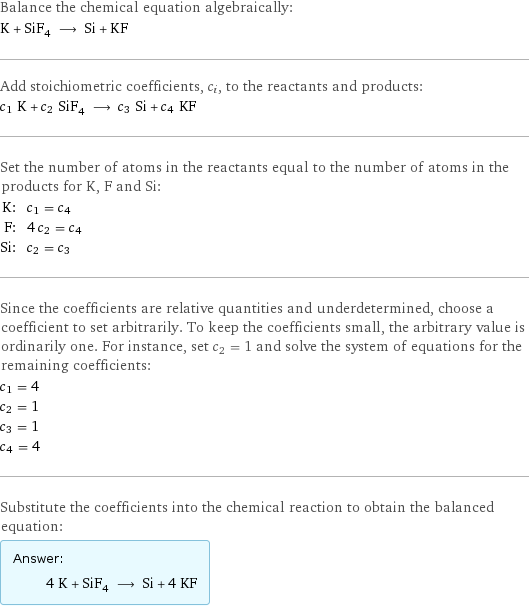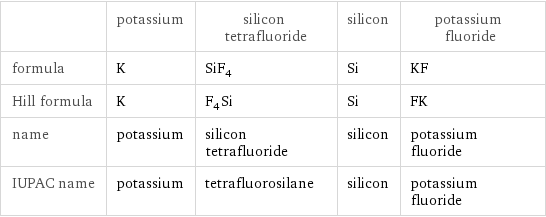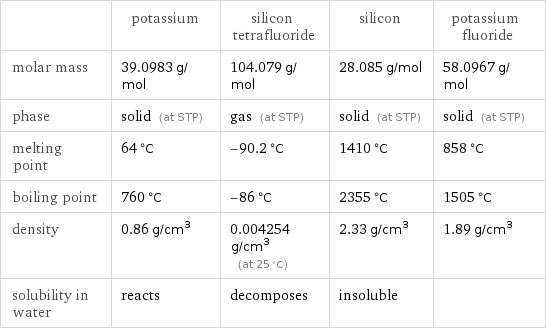Input interpretation

K potassium + SiF_4 silicon tetrafluoride ⟶ Si silicon + KF potassium fluoride
Balanced equation

Balance the chemical equation algebraically: K + SiF_4 ⟶ Si + KF Add stoichiometric coefficients, c_i, to the reactants and products: c_1 K + c_2 SiF_4 ⟶ c_3 Si + c_4 KF Set the number of atoms in the reactants equal to the number of atoms in the products for K, F and Si: K: | c_1 = c_4 F: | 4 c_2 = c_4 Si: | c_2 = c_3 Since the coefficients are relative quantities and underdetermined, choose a coefficient to set arbitrarily. To keep the coefficients small, the arbitrary value is ordinarily one. For instance, set c_2 = 1 and solve the system of equations for the remaining coefficients: c_1 = 4 c_2 = 1 c_3 = 1 c_4 = 4 Substitute the coefficients into the chemical reaction to obtain the balanced equation: Answer: | | 4 K + SiF_4 ⟶ Si + 4 KF
Structures

+ ⟶ +
Names

potassium + silicon tetrafluoride ⟶ silicon + potassium fluoride
Equilibrium constant
![Construct the equilibrium constant, K, expression for: K + SiF_4 ⟶ Si + KF Plan: • Balance the chemical equation. • Determine the stoichiometric numbers. • Assemble the activity expression for each chemical species. • Use the activity expressions to build the equilibrium constant expression. Write the balanced chemical equation: 4 K + SiF_4 ⟶ Si + 4 KF Assign stoichiometric numbers, ν_i, using the stoichiometric coefficients, c_i, from the balanced chemical equation in the following manner: ν_i = -c_i for reactants and ν_i = c_i for products: chemical species | c_i | ν_i K | 4 | -4 SiF_4 | 1 | -1 Si | 1 | 1 KF | 4 | 4 Assemble the activity expressions accounting for the state of matter and ν_i: chemical species | c_i | ν_i | activity expression K | 4 | -4 | ([K])^(-4) SiF_4 | 1 | -1 | ([SiF4])^(-1) Si | 1 | 1 | [Si] KF | 4 | 4 | ([KF])^4 The equilibrium constant symbol in the concentration basis is: K_c Mulitply the activity expressions to arrive at the K_c expression: Answer: | | K_c = ([K])^(-4) ([SiF4])^(-1) [Si] ([KF])^4 = ([Si] ([KF])^4)/(([K])^4 [SiF4])](../image_source/45724dd4e7c28daa3080e45031bb1faf.png)
Construct the equilibrium constant, K, expression for: K + SiF_4 ⟶ Si + KF Plan: • Balance the chemical equation. • Determine the stoichiometric numbers. • Assemble the activity expression for each chemical species. • Use the activity expressions to build the equilibrium constant expression. Write the balanced chemical equation: 4 K + SiF_4 ⟶ Si + 4 KF Assign stoichiometric numbers, ν_i, using the stoichiometric coefficients, c_i, from the balanced chemical equation in the following manner: ν_i = -c_i for reactants and ν_i = c_i for products: chemical species | c_i | ν_i K | 4 | -4 SiF_4 | 1 | -1 Si | 1 | 1 KF | 4 | 4 Assemble the activity expressions accounting for the state of matter and ν_i: chemical species | c_i | ν_i | activity expression K | 4 | -4 | ([K])^(-4) SiF_4 | 1 | -1 | ([SiF4])^(-1) Si | 1 | 1 | [Si] KF | 4 | 4 | ([KF])^4 The equilibrium constant symbol in the concentration basis is: K_c Mulitply the activity expressions to arrive at the K_c expression: Answer: | | K_c = ([K])^(-4) ([SiF4])^(-1) [Si] ([KF])^4 = ([Si] ([KF])^4)/(([K])^4 [SiF4])
Rate of reaction
![Construct the rate of reaction expression for: K + SiF_4 ⟶ Si + KF Plan: • Balance the chemical equation. • Determine the stoichiometric numbers. • Assemble the rate term for each chemical species. • Write the rate of reaction expression. Write the balanced chemical equation: 4 K + SiF_4 ⟶ Si + 4 KF Assign stoichiometric numbers, ν_i, using the stoichiometric coefficients, c_i, from the balanced chemical equation in the following manner: ν_i = -c_i for reactants and ν_i = c_i for products: chemical species | c_i | ν_i K | 4 | -4 SiF_4 | 1 | -1 Si | 1 | 1 KF | 4 | 4 The rate term for each chemical species, B_i, is 1/ν_i(Δ[B_i])/(Δt) where [B_i] is the amount concentration and t is time: chemical species | c_i | ν_i | rate term K | 4 | -4 | -1/4 (Δ[K])/(Δt) SiF_4 | 1 | -1 | -(Δ[SiF4])/(Δt) Si | 1 | 1 | (Δ[Si])/(Δt) KF | 4 | 4 | 1/4 (Δ[KF])/(Δt) (for infinitesimal rate of change, replace Δ with d) Set the rate terms equal to each other to arrive at the rate expression: Answer: | | rate = -1/4 (Δ[K])/(Δt) = -(Δ[SiF4])/(Δt) = (Δ[Si])/(Δt) = 1/4 (Δ[KF])/(Δt) (assuming constant volume and no accumulation of intermediates or side products)](../image_source/8e0940bf0a032b5f472a0a067d6d9a0d.png)
Construct the rate of reaction expression for: K + SiF_4 ⟶ Si + KF Plan: • Balance the chemical equation. • Determine the stoichiometric numbers. • Assemble the rate term for each chemical species. • Write the rate of reaction expression. Write the balanced chemical equation: 4 K + SiF_4 ⟶ Si + 4 KF Assign stoichiometric numbers, ν_i, using the stoichiometric coefficients, c_i, from the balanced chemical equation in the following manner: ν_i = -c_i for reactants and ν_i = c_i for products: chemical species | c_i | ν_i K | 4 | -4 SiF_4 | 1 | -1 Si | 1 | 1 KF | 4 | 4 The rate term for each chemical species, B_i, is 1/ν_i(Δ[B_i])/(Δt) where [B_i] is the amount concentration and t is time: chemical species | c_i | ν_i | rate term K | 4 | -4 | -1/4 (Δ[K])/(Δt) SiF_4 | 1 | -1 | -(Δ[SiF4])/(Δt) Si | 1 | 1 | (Δ[Si])/(Δt) KF | 4 | 4 | 1/4 (Δ[KF])/(Δt) (for infinitesimal rate of change, replace Δ with d) Set the rate terms equal to each other to arrive at the rate expression: Answer: | | rate = -1/4 (Δ[K])/(Δt) = -(Δ[SiF4])/(Δt) = (Δ[Si])/(Δt) = 1/4 (Δ[KF])/(Δt) (assuming constant volume and no accumulation of intermediates or side products)
Chemical names and formulas

| potassium | silicon tetrafluoride | silicon | potassium fluoride formula | K | SiF_4 | Si | KF Hill formula | K | F_4Si | Si | FK name | potassium | silicon tetrafluoride | silicon | potassium fluoride IUPAC name | potassium | tetrafluorosilane | silicon | potassium fluoride
Substance properties

| potassium | silicon tetrafluoride | silicon | potassium fluoride molar mass | 39.0983 g/mol | 104.079 g/mol | 28.085 g/mol | 58.0967 g/mol phase | solid (at STP) | gas (at STP) | solid (at STP) | solid (at STP) melting point | 64 °C | -90.2 °C | 1410 °C | 858 °C boiling point | 760 °C | -86 °C | 2355 °C | 1505 °C density | 0.86 g/cm^3 | 0.004254 g/cm^3 (at 25 °C) | 2.33 g/cm^3 | 1.89 g/cm^3 solubility in water | reacts | decomposes | insoluble |
Units
